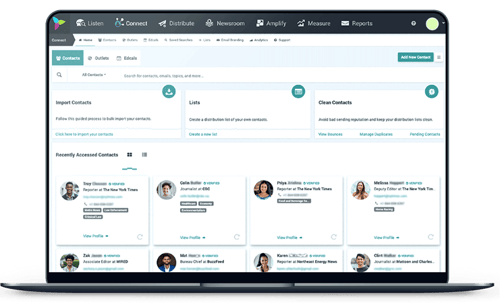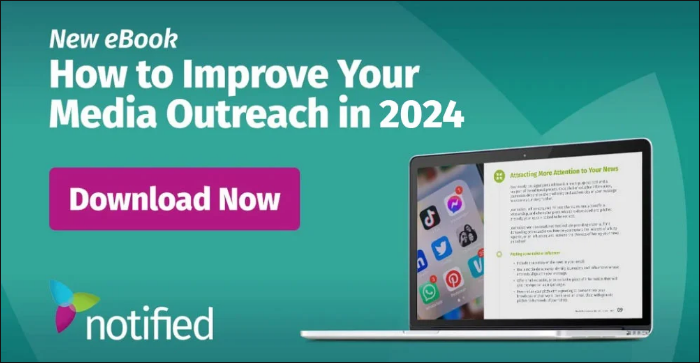Share this
How To Write an Effective Media Pitch
by The Notified Team on Apr 11, 2024 7:08:49 PM
Journalists are inundated by countless email pitches each day. For public relations pros, it's crucial to craft media outreach that’s personalized, relevant and tells an engaging story.
In this helpful blog, we’ll dive into the art of media pitching – and explain what it is, why it's important and how to write an effective pitch that captures interest and builds strong relationships.
Whether you're a PR pro or a business owner looking to garner coverage, this one is for you!

What Is a Media Pitch?
A media pitch is a personalized proposal sent to reporters with the aim of securing coverage for a product, service, business, cause or individual.
The goal of a media pitch is to give journalists, bloggers, editors and producers a quick overview of your story – to introduce them to the topic and gauge their interest in writing or talking about your news.
The Importance of Media Pitching
Media pitches play a pivotal role in PR and marketing for several reasons.
They help you:
- Gain Credibility and Authority: Earning media coverage from trusted news outlets and journalists can significantly boost your brand's credibility and establish you as an authority in your industry.
- Expand Reach: Media outlets often have large and targeted audiences. An earned placement has the potential to expose your brand, product or cause to thousands or even millions of new eyeballs.
- Bolster Market Presence: Press coverage raises your visibility and puts your brand on people's radar within your market. It serves as a channel to build brand awareness beyond your owned channels, against competitors in your industry.
- Influence Public Opinion: Positive news coverage has the power to shape how people perceive your brand and products. It acts as a third-party endorsement, enhancing your reputation.
- Drive Traffic and Engagement: Media mentions typically drive traffic, social shares and engagement. Online articles often include links back to your website or landing pages, directing interested readers to your online presence.
- Spark Interest and Sales: The exposure and validation from the media can directly ignite consumer interest and lead to increased sales or donations for nonprofit causes.
- Beat the Algorithm: Earning press coverage allows you to circumvent algorithms and directly reach wider audiences. It expands your reach beyond organic search and social media.
To achieve these benefits, it's essential to understand how to craft an effective media pitch that captures the attention of journalists and makes them want to cover your story!

How To Write an Effective Media Pitch
Writing an effective pitch requires strategy, research and careful crafting.
Here are the key steps to follow to improve your media relations and boost your outreach:
1. Research Your Journalists
Before you start writing your media pitch, conduct thorough research on the journalists, bloggers, editors or producers you want to reach.
You must understand their areas of interest, beat coverage and target audience. If you think like a journalist, you can tailor your pitch to their specific needs and preferences.
Pro Tip: You can use Notified’s Media Contacts Database to quickly identify human-verified journalists and build pitch lists!
2. Craft a Strong Subject Line
The subject line of your pitch (if it’s done via email, and not over the phone or in person) is the first impression you make, and it can make or break your chances of capturing a journalist's attention.
Summarize your story in a short, striking headline – ideally using only a few words – that highlights what makes it newsworthy and relevant to the journalist.
3. Personalize Your Pitch
To pique a journalist’s interest, referencing something specific from their previous coverage will help show that you've done your homework, and are familiar with their specific beat.
Personalization sets your pitch apart from generic mass emails and demonstrates that you value their expertise and interests.
4. Keep It Short and Sweet
Journalists are busy professionals with limited time to spare. You must keep your pitch concise and to the point.
Begin with a brief summary of the key details in the first two-to-three sentences, covering the who, what, when, where and why. Avoid dense blocks of text and make your pitch easily scannable.
Don’t bury the lead, and make sure that the most important details of your pitch are at the very top. As journalists often skim pitches quickly, opening with long-winded explanations or context will often lose their attention.
Pro Tip: Follow the Inverted Pyramid writing style – a technique where you present the most important information first, followed by supporting details. This helps journalists quickly grasp the main points of your story.
5. Make It Relevant
Connect your story to current news and events. Explain why it needs coverage today and why people should care about it.
Link it to popular trends or ongoing conversations and include data points to make it more appealing to journalists.
6. Highlight What's New and Different
Focus on what sets your story apart from others. If you have exclusive data, new research, or a unique angle - emphasize it!
Journalists are always looking for fresh and exceptional stories that will capture their audience's attention.
7. Back It Up with Facts
Support your pitch with facts, statistics, quotes or data that reinforces the significance of your story.
Journalists appreciate data that can be used to support their articles and add credibility to their reporting.
8. Explain the Impact
Describe the impact your story will have on the audience, community or industry.
Highlight the real-world implications to make your pitch more appealing and relevant to journalists.
9. Show How It Fits
Demonstrate how your story aligns with the recipient's beat or niche. Make it clear why their audience would be interested in your story.
The more relevant and tailored your pitch, the higher the chances of it being picked up.
10. Add Visuals
Visuals help bring stories to life. Always offer photos, videos, infographics or other multimedia materials that can enhance and illustrate your story visually.
But never include attachments – this could potentially trigger Spam filters. Always link to assets in the body of your email.
Pro Tip: Enriched Email in the Notified PR Platform lets you easily create feature-rich, engaging emails.
11. No Mass Emails!
Avoid sending the same email to every journalist on your list. Personalize each pitch to the specific media outlet you're targeting.
Use their preferred contact information and address them personally whenever possible. This shows that you value their individuality and increases the likelihood of capturing their attention.
12. Include a Clear Call to Action
End your pitch with a clear call to action, indicating how journalists can get in touch with you for more information or to schedule an interview.
Make it easy for them to take the next step if they're interested in your story.
13. Proofread and Edit
Before sending out your pitch, meticulously proofread it for typos, grammatical errors and clarity. Even consider sending it to yourself first, to potentially identify any formatting issues.
A well-written pitch demonstrates professionalism and attention to detail.
14. Follow Up
If you don't receive a response after a reasonable time, consider sending a polite follow-up email. Be mindful of journalists' busy schedules and avoid being pushy or aggressive.
A gentle reminder can sometimes be effective a few days after initially sending your pitch.
15. Respect Journalists’ Preferences
Some journalists prefer phone calls or social media messages instead of emails. Research their contact preferences and respect them.
Building relationships with journalists requires understanding their preferred communication channels.

Build Strong Relationships Using a Media Database
Media relations is an ongoing process that requires consistent relationship building. Take the time to connect personally with writers, reporters, editors and producers who cover your industry or niche.
Follow the journalists you pitch on social media, engage with their stories, share their articles and tag them if you mention them positively. Persistence in relationship-building pays off in the long run!
To streamline your media outreach efforts, consider using a media contacts database (such as Notified’s). Databases provide an organized list of journalists, reporters, bloggers, editors and other human-verified media contacts that you can pitch your stories to.
They provide:
- Centralized Contact Information: A media database keeps all your media contacts in one place, eliminating the need to search for individual emails.
- Customized and Segmented Lists: You can create targeted lists based on specific beats, interests or publication types. This enables you to send pitches to a highly relevant audience, improving your response and open rates.
- Updated Contact Information: Media databases ensure that contact information, such as new emails or changed beats, is regularly updated. This helps you stay up-to-date and maintain accurate records.
- Relationship Management: A media database allows you to track the history of pitches sent to each contact and their responses. You can also take notes on their preferences, ensuring you follow up appropriately and control the frequency of your pitches.
Using a media contacts database can streamline your pitching process, making it more efficient and organized. It helps you target your pitches strategically, customize follow-ups and build better relationships over time.
Thanks for reading – by using these best practices, you’ll enhance your brand storytelling and create strong relationships with journalists!
Learn About Our Verified Media Contacts Database
To learn more, check out our interactive tour of the Connect media database in the Notified PR Platform.
And if you want a firsthand look at our database, request a personalized demo to see how Notified can help make your media relations more efficient and more impactful!
Share this
- Public Relations (224)
- Press Releases (115)
- Press Release Distribution (94)
- GlobeNewswire (90)
- Investor Relations (88)
- PR Communications (74)
- Artificial Intelligence (71)
- Media Relations (50)
- IR Communications (41)
- Media Contacts Database (40)
- Global News Distribution (32)
- Webinar (32)
- IR Websites (30)
- Earnings Calls (22)
- Notified PR Platform (21)
- IR Webcasts (19)
- Experiences (17)
- Studio Webinar Platform (17)
- Virtual Events (17)
- Writing Tips (17)
- Case Study (16)
- PR Trends (16)
- Webcasts (16)
- PR Measurement (15)
- Generative AI (13)
- Media Monitoring (13)
- Event Technology (12)
- Investor Days (12)
- Webinar Strategy (12)
- ESG (10)
- Social Media (10)
- IR Event Platform (9)
- Newswire (9)
- United Kingdom (9)
- Virtual Event Platform (9)
- Accessibility (8)
- Earnings Day (8)
- Earnings Release (8)
- News Roundup (8)
- Regulatory Filing (8)
- Germany (6)
- Report (6)
- Social Listening (6)
- CLEAR Verified (5)
- IR Hub (5)
- Video (5)
- Webinar Engagement (5)
- Brand Storytelling (4)
- Misinformation (4)
- PR Agency (4)
- SEO (4)
- Trust (4)
- IR Trends (3)
- Journalism (3)
- AGM (2)
- Awards (2)
- Branding (2)
- CSR (2)
- Capital Narratives (2)
- DEI (2)
- Demand Generation (2)
- Insights & Analytics (2)
- ROI (2)
- Sentiment Analysis (2)
- Webhosting (2)
- Annual General Meeting (1)
- Canada (1)
- Emojis (1)
- Equiniti (1)
- Events (1)
- France (1)
- Halloween (1)
- Internal Communications (1)
- Internships (1)
- Life At Notified (1)
- Mark Cuban Foundation AI Bootcamp (1)
- Marketing (1)
- News Briefs (1)
- News Releases (1)
- PRSA ICON (1)
- Product Launch (1)
- Retail Investors (1)
- SXSW (1)
- Share of Voice (1)
- Sponsorships (1)
- Success Story (1)
- White Paper (1)
- eBook (1)
- September 2025 (3)
- August 2025 (6)
- July 2025 (9)
- June 2025 (12)
- May 2025 (9)
- April 2025 (11)
- March 2025 (11)
- February 2025 (6)
- January 2025 (12)
- December 2024 (12)
- November 2024 (12)
- October 2024 (14)
- September 2024 (15)
- August 2024 (14)
- July 2024 (14)
- June 2024 (14)
- May 2024 (12)
- April 2024 (13)
- March 2024 (13)
- February 2024 (15)
- January 2024 (11)
- December 2023 (7)
- November 2023 (13)
- October 2023 (14)
- September 2023 (7)
- August 2023 (8)
- July 2023 (7)
- June 2023 (8)
- May 2023 (8)
- April 2023 (5)
- March 2023 (5)
- February 2023 (8)
- January 2023 (9)



